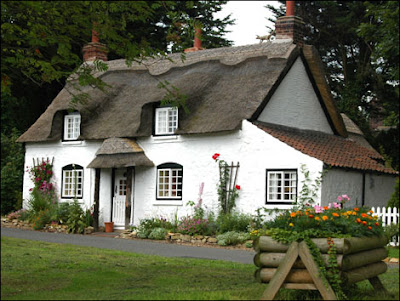What is thatching?
Thatching is the craft of building a roof with dry vegetation such as straw, water, rushes and heather. The method is to layer the vegetation so as to shed water away from the inner roof. It is a very old roofing method and has been used in both tropical and temperate climates. Thatch is still employed by builders in developing countries, usually with low-cost, local vegetation. It is also popular in some developed countries by the choice of wealthy people for aesthetic reasons for their home.
When did thatching begin?
In Europe, thatching has been used as a method of roofing at least since the Neolithic period, although it was probably used before this but there are no records to prove this. In most of Europe and the UK, thatch remained the only roofing material available to the bulk of the population in the countryside, and in many towns and villages, until the late 1800s. The number of thatched buildings in England decreased from one million in 1800 to 35,000 by 1960 because of machinery and transport enabling other materials to be used. Today there are around 24,000 listed thatched buildings in the United Kingdom. 5% of these are new builds and there are 1500 individuals engaged in thatching. Thatch has become much more popular in the UK over the past 30 years, and is now a symbol of wealth rather than poverty. Thatching is becoming popular again because of the renewed interest in preserving historic buildings, traditional crafting methods and using more sustainable building materials. There are more thatched roofs in the UK and Ireland than in any other European country.
Thatching Techniques
Here is a video showing the different techniques and stages of thatching:
http://www.youtube.com/watch?v=FrmhXww92Lk&feature=player_embedded
When applied by a skilled thatcher, a thatched roof can last to about 50 years until a new layer of straw needs to be applied over the original surface. This accumulates every 50 years to thatch around 2.1meters thick on old buildings. To begin with, roofs were thatched with wheat, rye or maslin, which is a mixture of both materials.
Thatch is fastened together in bundles with a diameter of about two feet. These are then laid on the roof with the butt end facing out and secured to the roof beams, after which they are pegged in place with wooden or steel rods. The thatcher adds the layers on top of each other, finishing with a layer to secure the ridge line of the roof. This method means thatch roofs are easy to repair, can endure heavy winds and rain and only need a stable supporting structure.
Advantages of a Thatched Roof
- Accessible materials, readily available all over the world
- Can be combined with other materials such as roof tiles
- Versatile material and can cover irregular roof structures and shapes
- Extremely sustainable and eco friendly due to the materials being natural
- Gives a beautiful rustic feel to any building, old or modern
Disadvantages of a Thatched Roof
- Can only be applied by a skilled worker, therefore expensive as well as being time consuming
- Can be damaged by nature such as extreme weather or animals
- Hard to insure due to fire risks
- Has to be redone approximately every 50 years






ReplyDeleteThis is a very nice post . I have visited the site many times and learn about Synthetic Thatch very nicely.
We are the Largest Supplier of No. 1 Quality Synthetic Thatch Roofing Material and Artificial Bamboo products supplying top-quality Synthetic thatch & Artificial Bamboo products with 20 Year Warranty, UV-proof, Class A flame-retardant, Maintenance-free. You’ll be astonished at how well our Synthetic Thatch Roofings withstand ocean breeze, heavy rain, snow storm, intense sunlight and general wear & tear for more than 20 years while still looking amazing.
Great read! Synthetic thatch roofing is such a smart solution for anyone wanting the natural, tropical look without the high maintenance of real thatch Synthetic Thatch Roof | Outdoor Umbrella | monsoon blinds | Synthetic Thatch Roof | pvc blinds | wooden venetian blinds | roller blinds for windows
ReplyDelete